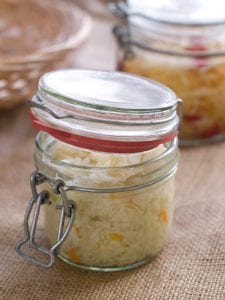
Poor digestion ranks right along with vitamin D deficiency as a key factor in the development of osteoporosis, osteopenia and needless fracture. Years ago I developed a simple 10 Steps to Stronger Digestion program that has helped countless individuals to enhance their digestion.
But I recently discovered that I overlooked an important ancient custom that can literally transform digestion — eating fermented foods.
Fermented foods bring our body’s ecology into balance, enhancing beneficial bacteria and controlling unwanted pathogenic bacteria. Fermented foods are tasty and making your own is economical, easy, and leaves you with a feeling of self-reliance. Most importantly, eating them on a daily basis can transform your digestion — it certainly has transformed mine. My top 3 favorite, easy ferment recipes are sauerkraut, pickled ginger, and kefir. I enjoy making and eating them!
Here’s how I make sauerkraut
1. Wash the cabbage and take off the tough outer leaves (one of which will be used later).
2. Shred the cabbage with a mandolin or knife.
3. Put the shredded cabbage in a large glass bowl. Thoroughly mix the crushed cabbage with your hands or a wooden spoon. Add 1 ½ teaspoons sea salt for each ½ head of large cabbage. (You can salt to taste. The salt helps the fermentation process, and controls undesirable bacteria). Juice should exude from the cabbage as it is crushed.
4. Firmly pack the crushed cabbage and its juices in a wide mouth quart size Ball canning jar. Press it down tightly with a spatula or wooden spoon. Make sure that all the air is out of the jar and the cabbage is packed in its juices.
5. Add spring water as necessary to cover the cabbage. Then cut one of the outer cabbage leaves to fit inside the jar, providing a sort of seal.
6. I use an air-lock jar cap which allows for release of the gases produced by fermentation without letting air into the jar. You want the process to be totally anaerobic, that is, without oxygen. You can make your ferment without an air-lock device, but using the lock solves the problem of messy overflow as the cabbage ferments. I put a shot glass on top of the leaf and screw on the air-lock cover, compressing the cabbage even further (others find this shot glass compression is not necessary to keep the cabbage covered with water).
7. The length of the pickling session varies depending on temperature and amount of salt. I let it sit for four days and then taste. My last batch was great at five days.
8. When you are satisfied with the taste, put a regular ball jar cover on the jar and refrigerate.
9. Enjoy!
![]() Every day is a new opportunity to grow and transform our body, mind and spirit.
Every day is a new opportunity to grow and transform our body, mind and spirit.![]()